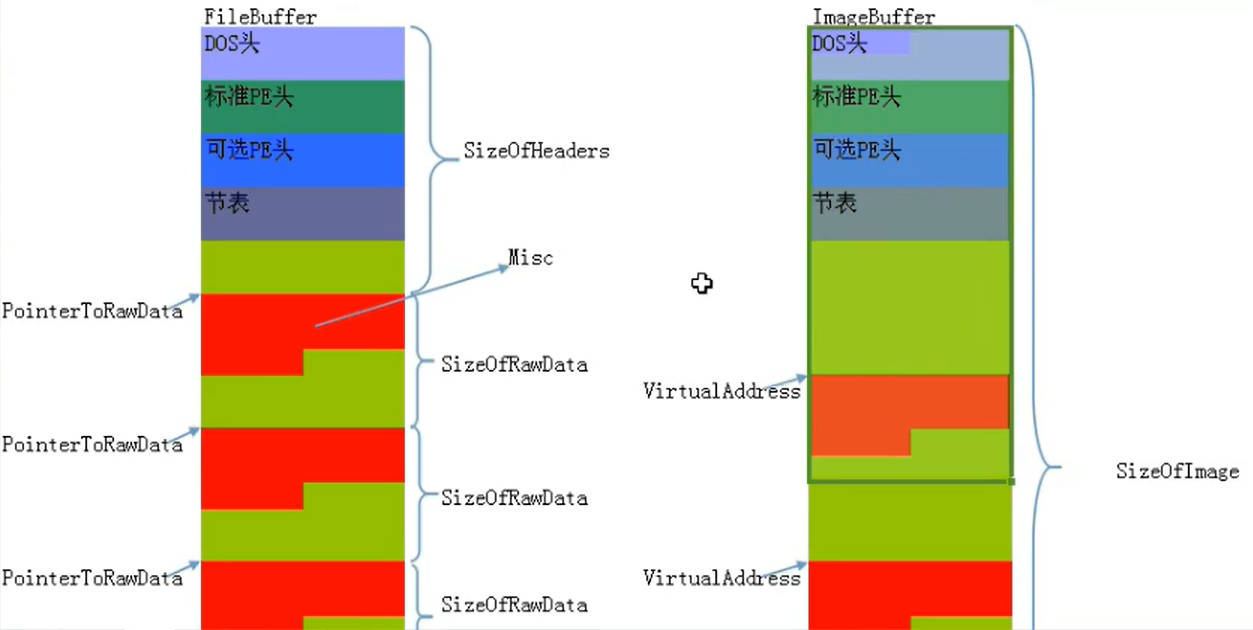1
2
3
4
5
6
7
8
9
10
11
12
13
14
15
16
17
18
19
20
21
22
23
24
25
26
27
28
29
30
31
32
33
34
35
36
37
38
39
40
41
42
43
44
45
46
47
48
49
50
51
52
53
54
55
56
57
58
59
60
61
62
63
64
65
66
67
68
69
70
71
72
73
74
75
76
77
78
79
80
81
82
83
84
85
86
87
88
89
90
91
92
93
94
95
96
97
98
99
100
101
102
103
104
105
106
107
108
109
110
111
112
113
114
115
116
117
118
119
120
121
122
123
124
125
126
127
128
129
130
131
132
133
134
135
136
137
138
139
140
141
142
143
144
145
146
147
148
149
150
151
152
153
154
155
156
157
158
159
160
161
162
163
164
165
166
167
168
169
170
171
172
173
174
175
176
177
178
179
180
181
182
183
184
185
186
187
188
189
190
191
192
193
194
195
196
197
198
199
200
201
202
203
204
205
206
207
208
209
210
211
212
213
214
215
216
217
218
| #include <iostream>
#include <windows.h>
#include "malloc.h"
#include <malloc.h>
PIMAGE_DOS_HEADER dosHeader = nullptr;
PIMAGE_FILE_HEADER fileHeader = nullptr;
PIMAGE_OPTIONAL_HEADER32 optionalHeader = nullptr;
PIMAGE_SECTION_HEADER* sectionArr = nullptr;
LPVOID MemoryData = nullptr;
LPVOID ReadProgramData(LPCSTR programPath)
{
FILE* program = nullptr;
size_t size = NULL;
LPVOID data = nullptr;
fopen_s(&program, programPath, "rb");
if (program == nullptr)
{
printf("failed to open by program!\n");
goto END;
}
if (fseek(program, 0, SEEK_END) == 0)
{
size = ftell(program);
if (fseek(program, 0, SEEK_SET) != 0)
{
printf("failed to move the pointer to begin!\n");
goto END;
}
}
else
{
printf("failed to move the pointer to end!\n");
goto END;
}
data = malloc(size);
if (data != nullptr)
{
memset(data, '\0', size);
fread_s(data, size, 1, size, program);
}
else
{
printf("failed to apply by memory\n");
goto END;
}
END:
if (program)
fclose(program);
return data;
}
void AnalyzePeStruct(PCHAR fileData, PIMAGE_DOS_HEADER& dos, PIMAGE_FILE_HEADER& file, PIMAGE_OPTIONAL_HEADER32& optional, PIMAGE_SECTION_HEADER*& section)
{
dos = (PIMAGE_DOS_HEADER)fileData;
fileData = &fileData[dos->e_lfanew + 4];
file = (PIMAGE_FILE_HEADER)fileData;
fileData = &fileData[20];
optional = (PIMAGE_OPTIONAL_HEADER32)fileData;
fileData = &fileData[file->SizeOfOptionalHeader];
section = (PIMAGE_SECTION_HEADER*)malloc(file->NumberOfSections * sizeof(IMAGE_SECTION_HEADER));
if (section != nullptr)
{
for (size_t index = 0; index < file->NumberOfSections; index++)
{
section[index] = (PIMAGE_SECTION_HEADER)fileData;
fileData = &fileData[40];
}
}
}
LPVOID ShrinkData(LPVOID memoryData)
{
LPVOID fileData = nullptr;
LPVOID tempMemoryDataPointer = nullptr;
LPVOID tempFileDataPointer = nullptr;
int copyCharNumber = NULL;
size_t fileDataSize = optionalHeader->SizeOfHeaders;
for (size_t index = 0; index < fileHeader->NumberOfSections; index++)
{
fileDataSize += sectionArr[index]->SizeOfRawData;
}
fileData = malloc(fileDataSize);
if (fileData != nullptr)
{
memset(fileData, '\0', fileDataSize);
tempMemoryDataPointer = memoryData;
tempFileDataPointer = fileData;
copyCharNumber = optionalHeader->FileAlignment;
while (copyCharNumber < optionalHeader->SizeOfHeaders)
{
copyCharNumber *= 2;
}
memcpy_s(tempFileDataPointer, copyCharNumber, tempMemoryDataPointer, optionalHeader->SizeOfHeaders);
for (size_t index = 0; index < fileHeader->NumberOfSections; index++)
{
copyCharNumber = optionalHeader->FileAlignment;
tempFileDataPointer = (LPVOID)((UINT_PTR)fileData + sectionArr[index]->PointerToRawData);
tempMemoryDataPointer = (LPVOID)((UINT_PTR)memoryData + sectionArr[index]->VirtualAddress);
while (copyCharNumber < sectionArr[index]->SizeOfRawData)
{
copyCharNumber *= 2;
}
memcpy_s(tempFileDataPointer, copyCharNumber, tempMemoryDataPointer, sectionArr[index]->SizeOfRawData);
}
}
return fileData;
}
LPVOID StretchData(PCHAR fileData)
{
LPVOID tempMemoryDataPointer = nullptr;
PCHAR tempFileDataPointer = nullptr;
int copyCharNumber = NULL;
AnalyzePeStruct(fileData, dosHeader, fileHeader, optionalHeader, sectionArr);
MemoryData = malloc(optionalHeader->SizeOfImage);
if (MemoryData != nullptr)
{
memset(MemoryData, '\0', optionalHeader->SizeOfImage);
tempMemoryDataPointer = MemoryData;
tempFileDataPointer = fileData;
copyCharNumber = optionalHeader->SectionAlignment;
while (copyCharNumber < optionalHeader->SizeOfHeaders)
{
copyCharNumber *= 0x2;
}
memcpy_s(tempMemoryDataPointer, copyCharNumber, tempFileDataPointer, optionalHeader->SizeOfHeaders);
for (size_t index = 0; index < fileHeader->NumberOfSections; index++)
{
copyCharNumber = optionalHeader->SectionAlignment;
tempMemoryDataPointer = (LPVOID)((UINT_PTR)MemoryData + sectionArr[index]->VirtualAddress);
tempFileDataPointer = (PCHAR)((UINT_PTR)fileData + sectionArr[index]->PointerToRawData);
while (copyCharNumber < sectionArr[index]->SizeOfRawData)
{
copyCharNumber *= 2;
}
memcpy_s(tempMemoryDataPointer, copyCharNumber, tempFileDataPointer, sectionArr[index]->SizeOfRawData);
}
}
return MemoryData;
}
bool WriteMyFilePeData(LPVOID fileData, LPCSTR newProgramPath)
{
FILE* newProgram = nullptr;
bool result = true;
size_t size = NULL;
fopen_s(&newProgram, newProgramPath, "wb");
if (newProgram == nullptr)
{
printf("failed to create by program!\n");
result = false;
goto END;
}
size = _msize(fileData);
fwrite(fileData, 1, size, newProgram);
END:
if (newProgram)
fclose(newProgram);
return result;
}
int main()
{
PCHAR fileData = (PCHAR)ReadProgramData("D:\\c\\0.exe");
LPVOID memoryData = StretchData(fileData);
LPVOID myFileData = ShrinkData(memoryData);
WriteMyFilePeData(myFileData, "D:\\c\\0.exe");
getchar();
free(memoryData);
free(myFileData);
free(fileData);
return 0;
}
|
